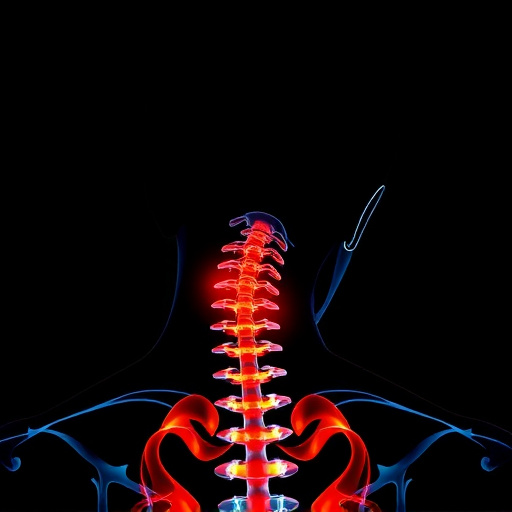Workplace injuries, especially musculoskeletal disorders like carpal tunnel, back strains, and prevalent whiplash, pose risks. Prevention involves hazard identification, training, breaks, and open communication. Whiplash treatment specialists provide specialized care for neck injuries using manual therapy, exercise, education, and mindfulness to reduce pain, enhance mobility, and prevent chronic issues. A comprehensive assessment is key, with modern treatments including tailored physiotherapy, cognitive behavioral therapy, and ergonomic principles in a supportive work environment. Understanding workers' rights and legal protections, like workers' compensation, ensures access to specialized care for severe injuries like whiplash.
Workplace injuries, particularly back and neck strains like whiplash, are prevalent yet often overlooked. This comprehensive guide explores various aspects of managing these issues. From understanding common causes and prevention strategies to the crucial role of a whiplash treatment specialist, we delve into effective assessment methods and innovative recovery treatments. Additionally, we examine ergonomics, employee wellness programs, legal considerations, and compensation resources, providing a holistic approach to addressing workplace-related injuries.
- Understanding Workplace Injuries: Common Causes and Prevention Strategies
- The Role of a Whiplash Treatment Specialist in Managing Workplace-Related Neck Injuries
- Comprehensive Assessment: Diagnosing and Evaluating Workplace Injury Claims
- Innovative Treatments for Effective Recovery from Work-Related Whiplash
- Creating a Supportive Work Environment: Ergonomics and Employee Wellness Programs
- Legal Considerations and Compensation for Workplace Injuries: Rights and Resources for Employees
Understanding Workplace Injuries: Common Causes and Prevention Strategies

Workplace injuries are a significant concern for employees and employers alike, with various factors contributing to their occurrence. Understanding the common causes is the first step towards implementing effective prevention strategies. One of the most prevalent issues is musculoskeletal disorders, often resulting from repetitive tasks or poor ergonomics. These can lead to conditions like carpal tunnel syndrome, back strains, and even whiplash, a common injury in occupations involving vehicle operations.
Prevention starts with recognizing potential hazards and taking proactive measures. Employers should provide adequate training on proper lifting techniques, offer ergonomic equipment, and ensure regular breaks during tasks that require prolonged concentration or physical exertion. Additionally, promoting a culture of open communication encourages employees to report concerns and symptoms early, facilitating timely intervention from whiplash treatment specialists and other healthcare providers.
The Role of a Whiplash Treatment Specialist in Managing Workplace-Related Neck Injuries

Whiplash, a common injury resulting from sudden jolts or accidents, often affects workers in high-risk industries or those involved in workplace accidents. When it comes to managing neck injuries related to whiplash, a Whiplash Treatment Specialist plays a pivotal role. These specialists are trained in diagnosing and treating this specific type of injury, which is crucial given the potential for long-term complications if left untreated.
They employ specialized techniques and therapies tailored to the individual’s needs, focusing on reducing pain, improving mobility, and preventing chronic issues. By assessing the extent of the whiplash, they can design a comprehensive treatment plan involving manual therapy, exercise regimes, and educational advice. This multidisciplinary approach ensures workers receive holistic care, speeding up recovery and facilitating a smoother return to work.
Comprehensive Assessment: Diagnosing and Evaluating Workplace Injury Claims

When it comes to workplace-related injuries, a comprehensive assessment is paramount to ensuring effective treatment and management. This process involves a thorough diagnosis and evaluation of the injured worker’s condition, including physical examinations, medical imaging, and a detailed review of their work history and circumstances surrounding the incident. The goal is to pinpoint the extent of the injury, identify any underlying conditions, and determine the best course of action for recovery.
Whiplash treatment specialists play a crucial role here, as these injuries are common in workplace accidents, particularly involving vehicles or heavy machinery. They utilize specialized techniques and expertise to assess and manage whiplash, ensuring that workers receive appropriate care tailored to their specific needs. This comprehensive approach not only facilitates faster healing but also paves the way for a safe and successful return to work.
Innovative Treatments for Effective Recovery from Work-Related Whiplash

Whiplash, a common injury resulting from sudden impacts or jolts, often affects individuals in workplace accidents. Traditional treatments for work-related whiplash include rest, physical therapy, and pain management medications. However, modern medicine has embraced innovative approaches to enhance recovery and restore patients’ mobility and quality of life. One such advancement is the integration of specialized physiotherapy techniques tailored by whiplash treatment specialists.
These specialists focus on manual manipulation and specific exercise regimes designed to alleviate neck pain, reduce muscle tension, and improve range of motion. Advanced technologies like cold therapy, heat therapy, and ultrasound are also employed to accelerate healing. Additionally, mindfulness practices and cognitive behavioral therapy have shown promise in managing the psychological aspects of whiplash recovery, addressing the often-associated stress, anxiety, and depression.
Creating a Supportive Work Environment: Ergonomics and Employee Wellness Programs

Creating a supportive work environment is paramount in comprehensive workplace injury care. Ergonomics play a pivotal role in preventing and managing injuries, especially those related to repetitive motions and poor posture. By implementing ergonomic assessments and designing job stations that promote proper body alignment, employers can significantly reduce the risk of musculoskeletal disorders, including whiplash treatment specialist visits. A culture that prioritizes employee wellness through regular health screenings, fitness programs, and mental health support further enhances overall well-being and fosters a proactive approach to injury prevention.
Employee wellness programs tailored to specific job roles can be game-changers in creating a healthy work environment. These initiatives may include training sessions on correct lifting techniques, breaks for stretching and relaxation, and educational workshops on stress management and posture awareness. Such programs not only help prevent immediate workplace injuries but also foster long-term employee satisfaction and retention, ultimately contributing to a more productive and engaged workforce.
Legal Considerations and Compensation for Workplace Injuries: Rights and Resources for Employees

When it comes to workplace injuries, understanding legal considerations and compensation options is crucial for employees. The first step in navigating this process involves recognizing your rights as a worker. Depending on jurisdiction, employees are entitled to receive medical treatment, wage replacement, and other benefits if they suffer an injury on the job. These rights are often protected by labor laws and regulations that mandate employers provide a safe workplace environment.
In cases of more severe injuries, such as whiplash, a common result of workplace accidents like car crashes or slip-and-falls, employees may require specialized treatment from a whiplash treatment specialist. This can include physical therapy, chiropractic care, and medication to manage pain and facilitate recovery. Additionally, workers’ compensation insurance plays a significant role in ensuring employees receive the necessary medical care and financial support during their recovery period. Understanding these legal protections and available resources empowers employees to seek appropriate care and assert their rights when workplace injuries occur.














